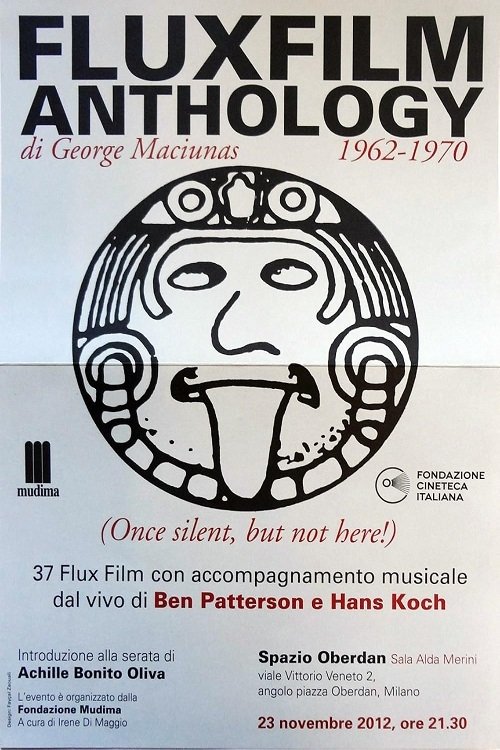
Fluxfilms
(PT)
Number of Movies: 37
Overview
We don't have an overview translated in English. Help us expand our movieDetailsbase by adding one.
Featured Cast
Self - Performer
Featured Crew
Directing
37 Movies
March 21, 1964
In an endless loop, unexposed film runs through the projector. The resulting projected image shows a surface illuminated by a bright light, occasionally altered by the appearance of scratches and dust particles in the surface of the damaged film material. This a film which depicts only its own material qualities; An "anti-film", meant to encourage viewers to focus on the lack of concrete images.
January 1, 1966
"INVOCATION is Higgins' Satie movie... the purest attempt to clear art from any or all historical, esthetic, thematic, ornamental claptrap to regain the lost-eye consciousness." - Jonas Mekas
March 10, 1966
Word & number gag, no camera.
March 9, 1966
A smile gradually fades into a neutral facial expression.
March 9, 1966
Flicker: White and black alternating frames.
March 10, 1966
Time counter, in seconds and minutes.
January 1, 1966
Prestype on clear film measuring tape, 10ft. length. No camera. At the end of every foot of film numbers appear, 1, 2, etc to 10
January 1, 1966
Numerals on clear film from 1 to 1000."
March 10, 1966
A 16 mm film, featuring Yoko Ono's own eye slowly blinking, shot by Peter Moore with a high-speed camera at 2,000 frames per second, which is projected at normal speed, 24 frames per second, thus creating a slow-motion effect.
December 31, 1966
Features entrance and exit door signs, fading through black and white.
January 1, 1966
Begins with a picture of Marilyn Monroe, then shifts to a female body, shot from belly button down, which is wriggling under piles of cellophane.
January 1, 1966
Begins with a shot of a demarcation line on an asphalt tennis court. A hand points to the distant landscape, then numbers 408 and 409 appear on a female torso.
January 1, 1966
X-ray sequence of mouth and throat; eating, salivating, speaking.
March 10, 1966
Collected as part of the Fluxfilm Anthology (a multi-reel compendium of 37 short films assembled by Fluxus founder and central operator George Maciunas), One captures the lifespan of a single match recorded at 2,000 frames per second using a 16mm high-speed camera. The frame rate is then decelerated to the standard 24fps for presentation. The film emphasizes each gesture, sway and flare of flame as the small pinewood carrier ignites across the landscape of the filmstrip and screen, signalling the drama and poetics of this ”minor” event before the fire is extinguished. One also stands as an unassuming beacon, immortalizing on film the essence of some of Ono’s early concerns as an artist. At the slightest touch of fire, they burst into flame. Strike everywhere. Strike often.
January 1, 1966
Sorry, we have no overview for this movie.
February 6, 1966
This film consists entirely of close ups of famous persons' bottoms. Ono meant it to encourage a dialogue for world peace.
January 22, 1966
A handful of rocks and chestnuts falling, filmed with high speed camera.
March 9, 1966
Shot at 2,000 frames per second, this short shows a man exhaling smoke in incredibly slow motion.
January 1, 1966
Single frame exposures, color. Different image each frame, various items in the room, etc.
January 1, 1966
Artype patterns, intended for loops. Benday dot patterns. Dots, lines. Screens, wavy lines, parallel lines, etc. on clear film. No camera.
January 1, 1966
This is fluxfilm No. 21 and without a title
March 10, 1966
Close-ups of two faces, shouting at each other.
July 7, 1963
"Single Frame sequences of TV or film images, with periodic distortions of the image. The images are airplanes, women men interspersed with pictures of texts like: 'silence, genius at work' and 'ich liebe dich.' The end credit is 'Television décollage, Cologne, 1963."
January 1, 1966
Color test strip from developing tank.
January 2, 1966
Following a series of title cards, a man in sunglasses briefly flutters his hands like fairy. Owen Land states that this film was not made by George Landow, and believes it should be credited to John Cavanaugh. "George Maciunas had a number of films which didn’t have titles on them. Then he put them together into his Fluxus reel and tried to remember who made them. It was an intentional Fluxus joke." (Owen Land, interview with Mark Webber, 2004)
January 1, 1965
Each film frame is a different image from the Sears Roebuck mail order catalogue. The film places pictures of the objects sold by Sears to the consumer society side by side with pictures of female models
January 1, 1965
Single frame exposures of dot-screens.
January 1, 1965
Various gestures of hand held razorblade, single frame exposures.
January 1, 1966
Single frame exposures of words.
January 1, 1966
"Face Smiling. Hammering a brick. CU of an ear (moving?). Face twitching. Dancing on one leg. Rolls, twitches on the floor. Boxes the wall."
January 1, 1966
Cale makes a short film called Police Car. No sound, and it is in black & white. Part #31 in the Fluxus Film series.
January 1, 1970
Tips of feet walking at the edge of frame, all around the frame.
January 1, 1970
Face going out of focus by layering sheets of plastic between camera and subject.
January 1, 1966
Seeing, Hearing, Saying Nothing. Ben stands with ears, eyes, mouth bandaged.
January 1, 1963
Swimming across Nice harbour fully clothed. Ben swims across a bay in Nice.
January 1, 1969
Lifting and holding up a chest of drawers.
January 1, 1962
Sitting on a promenade in nice with a sign: Watch me, that’s all.
© All Rights Reserved 2025